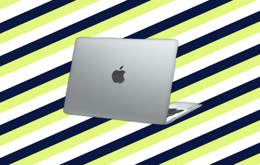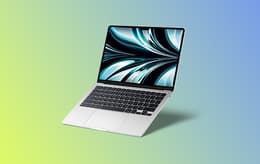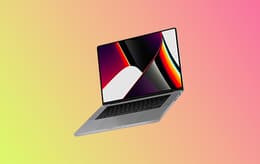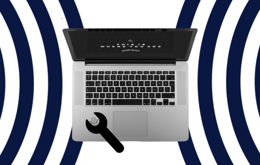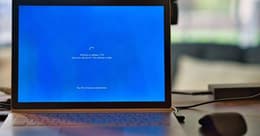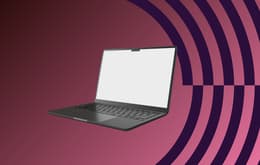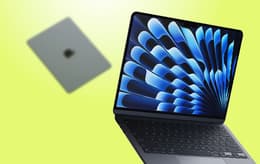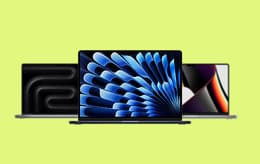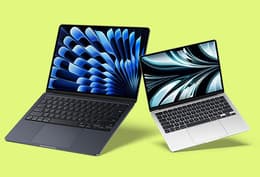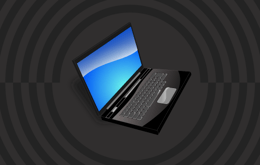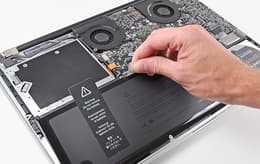
The release of the M4 chip in 2024 was a serious scale-up over Apple's previous chips, particularly in performance and energy efficiency. It's a significant upgrade to the M3 chip, which itself was a game changer for computer processing needs and elevated industry standards. Now let's explore the difference between the M1 vs M2 vs M3 vs M4 chips to provide clarity and help guide your next Mac buying decision.
Comparing the M1 vs M2 vs M3 chips, and what the M4 chip brings to the table
The very first silicon chip produced by Apple, the M1, released in 2020, put new computers way ahead of older models. Without the M1 chips, devices lacked when it came to battery life, processing power, graphics performance and memory.
The M2 chip, released in 2022, featured several upgrades. It included even more transistors than the M1, making it quicker in processing data and allowing it to run certain heavy-duty applications more smoothly. This is especially important for video editors, as the M2 chip has better support for ProRes and ProRes RAW files.
The M3 chip was released in late 2023. As opposed to the 5nm process that is used by both the M1 and M2 chips, the M3 is a 3nm chip, meaning its transistors are even smaller. This leads to even higher and faster performance while maintaining a long battery life, which is the main difference between the M2 and M3 chips.
The latest M4 chip can execute up to 38 trillion operations per second, which is double the capability of the M3. It also has a new 10-core configuration, up from the 8-core M3 CPU. This gives it a roughly 20% edge in performance. It also introduces support for hardware-accelerated AV1 media decoding, which is a brand-new feature. This chip has three models: M4, M4 Pro and M4 Max.
Let’s break it down in a table below to find out what all this means and which chip is best for which tasks:
Category | Best processor |
Best overall | M4 Max |
Best for large files | M4 Pro |
Best for moderate use | M3 |
Best for basic use | M1 |
Best value | M2 |
Best CPU capacity | M3 Ultra |
Best memory bandwidth | M4 Max |
Best for office work | M3 |
Best for students | M3 |
Best for advanced photo and video editing | M4 Max |
Best for gaming experience | M4 Max |
Rating Criteria
While there is pressure to upgrade computers and devices consistently, M1 and M2 processors are not lacking in capability. If you do word processing, web browsing and light image editing, an Apple machine with an M1 processor will still provide lightning-fast receptivity. However, for heavier tasks like video editing and high-resolution image retouching, the M4 models improve your machine’s ability to render files quickly.
Best overall chip: M4 Max
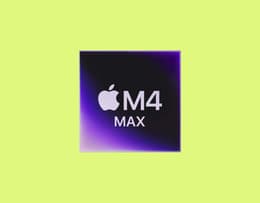
Best overall chip: M4 Max.
Why it's the best Apple chip
The M4 Max is the most powerful chip that Apple has released. It offers an extremely smooth gaming experience and fast rendering. It has a large 546 GB/s memory bandwidth, which enables very high performance levels and lightning-fast data transfer. It incorporates advanced AI processing, making it the best choice for all high-end, intensive computing tasks like data science and 3D graphics.
Key features:
16-core CPU with 12 performance cores and 4 efficiency cores.
40-core GPU.
2 ProRes hardware ray tracing accelerators.
16-core Neural Engine.
546 GB/s memory bandwidth.
Media Engine. Hardware-accelerated H.264, HEVC, ProRes, ProRes RAW and new AVI decoding. Two video decode engines + two ProRes encoders.
Average price new: £2550.00
Who it's for
Ideal for those who want a powerful top-end MacBook, MacBook Air or iMac, it’s suitable for the high-intensity processing required by graphic designers, gamers and professionals who deal with large data files.
Pros
The M4 Max offers exceptionally fast and powerful performance, up to 20% faster than the preceding M3 in both CPU and GPU. It has a new nano-texture display, which enhances screen clarity while reducing glare. The chip supports more SDR brightness, up to 1,000 nits. An extended battery life reduces the need for charging and can last for up to 24 hours, depending on the type of usage.
Cons
The M4 Max has a noticeable loss of performance when the laptop is in low-power mode. This can be an issue for those who like to work in this mode to conserve battery life. The cost is another factor, as these premium machines come with price tags to match.
Best chip for everyday use: M3

Why it's the best Apple chip for everyday use
The M3 is noteworthy for its long term value. The M3 offers processing power beyond the current availability and will remain relevant for the ensuing decades. As long as you are satisfied with your M3, it will serve you very well.
Key features:
8-core CPU with 4 performance cores and 4 efficiency cores.
Configurable to 8-core GPU and 10-core GPU.
Hardware-accelerated ray tracing.
16-core Neural Engine.
100GB/s memory bandwidth.
Media Engine. Hardware-accelerated H.264, HEVC, ProRes, and ProRes RAW. Video decode engine.
Average price new: £1400
Ideal for those who want a powerful MacBook or iMac suitable for large files and robust workloads.
Pros
With the M3, users will appreciate fast processing and swift rendering for large files. As the M3 has been redesigned and reduced to a 3nm node size, with smaller being better in terms of chips, compared to the M1 and M2’s 5nm node, the M3 is Apple’s basis for future processing generations. Beyond that, Apple does not have a reputation for the best gaming machines. The M3 is actually suitable for gaming and places Apple in the gaming arena.
Cons
The main disadvantage of the M3 is its higher price than the M1 and M2, but if you need its power, it is the way to go.
Best Apple Chip Value for the Price: M2

Why it's the best Apple chip for affordability
The Apple M2 is suitable for those who are working with larger files. However, if you are not creating cutting-edge graphics, it is only 15% slower than the M3. You still have plenty of bandwidth to perform tasks that are heavier than word processing or web browsing.
Key features:
8-core CPU with 4 performance cores and 4 efficiency cores.
10-core GPU.
16-core Neural Engine.
100 GB/s memory bandwidth.
Average Price of new: £1400.00
Who it's for
Great for cost-conscious users who plan to work on their MacBook or iMac regularly, with some image or video processing.
Pros
If you do some graphics or video editing work, the M2 is a great option, as it can be less costly than the M3. Users still receive good performance, which is only 15% slower than the M3. With the M2 Pro or an M2 maximum-powered laptop, the efficiency is similar to the M3, nullifying the need for an urgent upgrade.
Cons
As with all Apple products, the M2 will eventually become obsolete. If you want to stay ahead of the curve, the M3 or M4 are the basis for future processor generations.
Best Apple Chip for Basic Users: M1

Why it's the best Apple chip for basic users
For those who know that they will be using their MacBook or iMac for light tasks, including web browsing or word processing, the M1 offers a great solution. The M1 is highly suitable for basic office and administrative tasks or student work, including functions like word processing, spreadsheets and other non-graphics or photo/video-editing applications.
Key features:
Battery and power: Up to 17 hours wireless
Memory: 8 GB
Storage: 256 GB SSD
Average price of new: £550.00
Who it's for
Ideal for those who need a basic but reliable computer for light tasks, such as students or office/administrative workers.
Pros
The M1 offers excellent performance, reliability and durability for which Macs are known. Though Apple has advanced their processing roster, the M1 will still provide a reliable machine for basic tasks for years to come.
Cons
The main disadvantage of the M1 is that it is significantly slower than the M3. This does not make a difference for tasks like web browsing, spreadsheets and word processing. However, it is not ideal for graphic-intensive tasks like video editing or 3D rendering.
M1 vs M2 vs M3 vs M4 chip pricing
When determining which machine with which processor is best for your computer needs, price is an important factor. Here are some things to consider:
While the M4 is the most powerful Apple chip available from Apple, its price range is much higher than the M3, which is still an extremely capable chip set. The lowest price for a refurbished M4 is *£829.00, while you can still find a MacBook M3 12-inch model at *£250.00. That's a massive difference by any measure.
Refurbished M2s can be found starting from the *£662.00, depending on their storage configurations, while new M2 machines start at around *£1249.00.
Refurbished models with M1 processors can be found for under *£401.00, but it’s important to understand if great value on an Apple machine is going to suit your needs.
When investing in a new desktop or laptop machine, refurbished MacBooks can provide an excellent opportunity for savings. However, how you plan to use your device makes a difference. Consistent high-resolution image editing or video editing runs better on a more powerful processor, like the M4 and M3, while the M2 and M1 are suitable for lighter daily tasks.
MacBook M1 vs M2 vs M3 vs M4 buying tips
When evaluating which Apple computer to purchase, refurbished models offer great savings. Refurbished computers offer a substantial discount that can amount to hundreds in savings, along with a smaller carbon footprint. Back Market, a reputable refurbished electronics retailer, performs a quality check on all merchandise, plus all models come with a 1-year warranty.
In addition, Back Market is a great option for students who are going back to school for the new term. Beyond Back Market’s initial savings, they offer a special student discount on all purchases of £250 or more. All you have to do is sign up, fill out the student form (it only takes 2 seconds!), and get your code for £20 off of any product on Back Market.
Evaluate your usage: Is your creative output suffering from your machine’s lack of processing capability? Do you simply need a standard MacBook for general tasks? These factors make a difference in whether you should choose the M1 vs M2 vs M3 chip or the newest M4 chip.
Review your budget: Apple computers can vary widely in price. Evaluate how much you can spend, and then peruse prices for new and refurbished models.
Research: Certain times of the year, such as Black Friday, can provide additional discounts on electronics, while knowing which models are releasing when can help you determine when to shop.
Compare the models: If you are uncertain about buying an Apple Mac online, check out our guides on how to select a MacBook. Take notes about what you like or dislike. This can help you narrow down the options when shopping online.
Additional considerations when choosing MacBooks with M1 vs M2 vs M3 vs M4
When comparing M1 vs M2 vs M3 vs M4 chips for your needs, you may also want to take some other factors into consideration.
As far as working with graphics, videos, high-resolution images and other visual tasks, the M1, M2 and M3 are all structured around eight GPU cores. You can upgrade your Mac to elevated specifications, such as a 10-core GPU; this can improve the performance of your M2 for tasks like speed and battery life. This can be done for the M1, but it is more advisable for the M2. By contrast, the newer M4 chip has a huge 40-core setup. This is a serious consideration if you do image-heavy work, like 3D rendering or video editing. More GPU cores will help streamline and improve rendering times. This built-in ability and higher price should be balanced against the option of upgrading an M2 or M3 instead.
Warranty and customer support
If you purchase an Apple-certified refurbished MacBook or iMac, it typically includes a one-year warranty. This offers great peace of mind along with the savings that refurbished models provide.
Apple also offers AppleCare+, in which Mac users can purchase protection for their device on an annual or multi-year basis. Beyond that, Back Market offers BackUp, a subscription-based protection plan that is available for 12 or 24 months of accidental breakage or liquid damage. It includes two repairs or one replacement per year, with 24-hour claim approval and repairs processed in three days when mailed in.
Conclusion: the best Apple processor between M1 vs M2 vs M3 and the new M4
Overall, understanding which processor to choose as well as the difference between the M1 and M2 chip involves evaluating your daily workflows, anticipated future tasks and your budget for investing in Macs over the ensuing years. M1 vs M2 chips, as well as the M3, all offer quality performance with substantial longevity.
If you are looking for a trustworthy computer, you cannot go wrong with Apple’s stellar offering of laptops and desktops. Deciding between M1 vs M2 vs M3 chips and the newest M4 is a matter of customisation to your specific needs. Once you have determined the ideal chip for your MacBook or iMac, there are many resources available to support your purchase. Refurbished electronics are a great way to reduce e-waste while benefiting your pocket. The consistently good reviews of MacBooks with M1, M2, M3 and M4 chips, along with Apple’s available customer support programmes, offer reassurance of your purchase.
Utilising this buying guide and evaluating your plans and needs can help you make an informed decision about which Apple processor is best.



